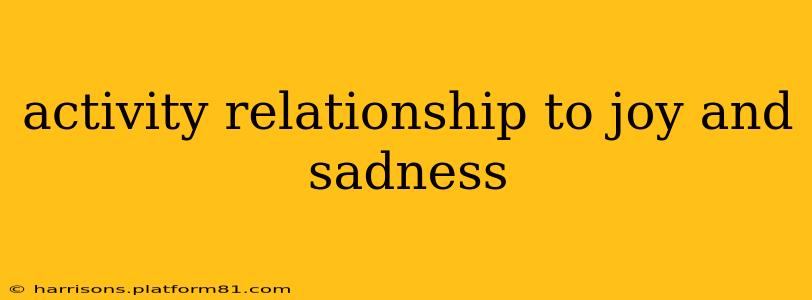Physical activity is often touted for its physical health benefits, but its impact extends far beyond a stronger heart and toned muscles. It plays a surprisingly significant role in our emotional well-being, influencing both our experience of joy and sadness. This intricate relationship is multifaceted and deserves a closer look.
How Does Physical Activity Affect Joy?
The connection between activity and joy is largely driven by the release of endorphins. These natural mood boosters act as neurotransmitters, interacting with receptors in the brain to reduce pain perception and create a sense of euphoria. This "runner's high," often experienced after intense exercise, is a testament to the power of physical activity to elevate mood and foster feelings of joy.
Beyond endorphins, regular physical activity offers several other pathways to joy:
- Improved Self-Esteem: Achieving fitness goals, whether it's running a 5k or mastering a new yoga pose, boosts self-esteem and confidence, contributing significantly to overall happiness.
- Stress Reduction: Physical activity is a highly effective stress reliever. Exercise helps regulate cortisol, the stress hormone, leaving you feeling calmer and more positive.
- Social Connection: Joining a sports team, attending fitness classes, or simply exercising with a friend fosters social interaction and a sense of belonging, both crucial for well-being.
- Accomplishment and Purpose: Setting and achieving fitness goals provides a sense of accomplishment and purpose, contributing to a more fulfilling and joyful life.
Does Physical Activity Impact Sadness?
While physical activity can't magically erase sadness, it offers several mechanisms to alleviate its symptoms and improve mood during times of emotional distress:
- Distraction: Engaging in physical activity provides a healthy distraction from negative thoughts and rumination, offering a temporary respite from sadness.
- Improved Sleep: Regular exercise can significantly improve sleep quality, which is often disrupted during periods of sadness or depression. Better sleep, in turn, contributes to improved mood regulation.
- Reduced Symptoms of Depression: Studies consistently demonstrate a correlation between regular physical activity and reduced symptoms of depression. The exact mechanisms are still under investigation, but the combined effects of endorphin release, stress reduction, and improved sleep likely play a major role.
- Increased Energy Levels: Sadness often leads to lethargy and low energy. Physical activity, even in small doses, can combat this fatigue and boost energy levels, making it easier to engage in other activities that promote well-being.
How Much Activity is Needed to Experience These Benefits?
The good news is you don't need to become a marathon runner to reap the emotional benefits of physical activity. Even moderate-intensity exercise, such as a brisk walk for 30 minutes most days of the week, can significantly impact your mood. The key is consistency and finding activities you enjoy.
Can Exercise Worsen Sadness?
While rare, in some individuals, particularly those with severe depression or certain medical conditions, strenuous exercise might temporarily worsen symptoms. It's crucial to listen to your body and consult with a healthcare professional before embarking on a new exercise regimen, especially if you are experiencing significant emotional distress.
What Types of Physical Activity Are Best for Mood Improvement?
The most effective type of physical activity is the one you enjoy and are most likely to stick with. This could be anything from dancing and swimming to hiking and weightlifting. Variety is also beneficial, as it prevents boredom and keeps you motivated.
Does the intensity of the activity matter?
While moderate-intensity exercise is generally recommended for overall well-being, the intensity level that optimally improves mood can vary from person to person. Experiment to find what works best for you. Some find high-intensity interval training (HIIT) incredibly energizing, while others prefer gentler activities like yoga or tai chi.
In conclusion, the relationship between physical activity and emotions, particularly joy and sadness, is complex but demonstrably significant. Regular physical activity offers a powerful and accessible tool to enhance emotional well-being, fostering a greater sense of joy and mitigating the effects of sadness. The key is finding an activity you enjoy and making it a consistent part of your routine.
